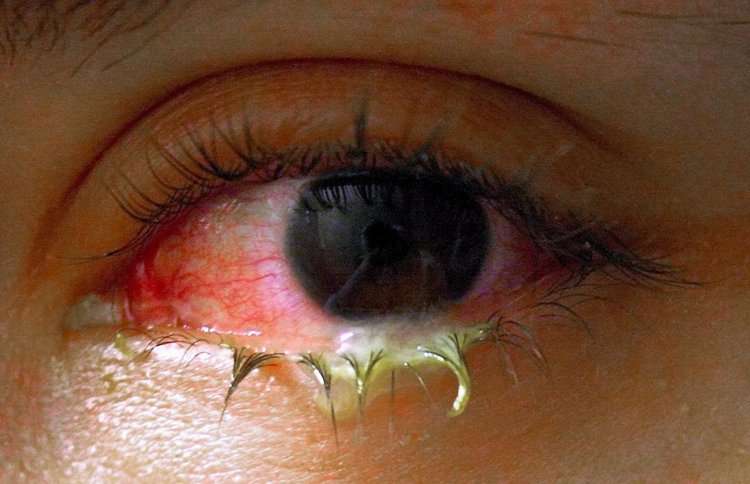
Popularly known as pink eye, conjunctivitis can be caused by virus, bacteria and allergens. Other causes may include chemicals, contact lenses, and foreign bodies in the eye, air pollution, fungi, amoeba and parasites. Though the exact cause of conjunctivitis may be difficult to detesrmine due to the similarity in symptoms of cases, bacterial and viral conjunctivitis are usually easily diagnosed.
Viral conjunctivitis is a highly contagious acute conjunctival infection, usually caused by an adenovirus. Symptoms include irritation, photophobia, and watery discharge. Diagnosis is clinical; sometimes viral cultures or immunodiagnostic testing are indicated. Infection is self-limited, but severe cases sometimes require topical corticosteroids.
Bacterial conjunctivitis can be caused by Staphylococcus aureus, Streptococcus pneumoniae, Haemophilus influenzae, Moraxella catarrhalis, or, less commonly, Chlamydia trachomatis and Neisseria gonorrhoeae. Bacterial conjunctivitis is one of the most commonly encountered eye problems. Most cases are acute, self-limited, and not a major cause of morbidity. However, because of its high prevalence, it has a large societal impact in terms of missed days of school or work.
Antibiotics can quicken the management of symptoms and microbial elimination and are therefore typically used to allow patients to return to their daily activities faster and to decrease the spread of disease. Chronic and hyperacute forms of bacterial conjunctivitis, typically due to Chlamydia trachomatis and Neisseria, respectively, are entirely different entities that are associated with high levels of ocular and systemic morbidity.
Allergic conjunctivitis can occur as a result of the body’s reaction to certain allergens, such as pollen from trees, grasses and weeds. Though not contagious, it occurs more frequently in people suffering other allergic conditions, such as hay fever, asthma and eczema. This type of conjunctivitis also happens seasonally when allergens, such as pollens are high.
Another type of conjunctivitis is that caused by irritants, such as a foreign body in the eye, smoke, dust or chemical or when one’s contact lenses are not properly cleaned. It is usually not contagious.
The actual cause of a conjunctivitis infection can be determined by a trained doctor, based on the patient’s history, symptoms and an examination of the eye. While conjunctivitis always involves redness and swelling of the eyes, there are other varying symptoms that indicate the exact cause of an infection. These symptoms can help the doctor in arriving at the definite cause of a case. However, there are instances when it becomes very difficult to determine the particular cause of an infection, owing largely to the fact that some symptoms are the same, irrespective of the cause.
Viral and bacterial conjunctivitis are very contagious. They can easily spread from person to person. One can reduce the risk of contracting the infection or transmitting it to others by observing some simple steps, such as washing of the hands with soap and water after cleaning the eye/applying eye drops, using alcohol-based hand sanitisers to clean the hands, avoiding rubbing or touching the eyes, washing one’s pillow cases, avoiding the use of contact lenses without the doctor’s advice and avoiding the use of swimming pools.
Seeking medical attention for conjunctivitis is good but there are times when it is not necessary. One can seek medical care when conjunctivitis comes with the following complaints: pain in the eye(s), sensitivity to light or blurred vision that does not improve when discharge is wiped from the eye(s), severe redness in the eye(s), worsening symptoms like pink eye, a weakened immune system due to underlying conditions, etc.
If your children have infectious conjunctivitis, do not allow them to share eye drops, tissues, make-up, towels or pillowcases with other people. Children with infectious conjunctivitis should be kept home from child care, kindergarten or school, until the discharge from the eyes has cleared. Be sure to regularly wash hands thoroughly to prevent the infection spreading to others.
New-borns with conjunctivitis develop drainage from the eyes within a few days to several weeks after birth. Their eyelids become puffy, red, and tender. The cause of neonatal conjunctivitis is often difficult to determine because, in many instances, the symptoms do not vary by cause.
Conjunctivitis in a new-born may be caused by a blocked tear duct, irritation produced by the topical antimicrobials given at birth, or infection with a virus or bacterium passed from the mother to her baby during childbirth. Even mothers without symptoms (asymptomatic) at the time of delivery can carry and pass bacteria or viruses to babies during birth.










